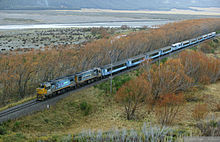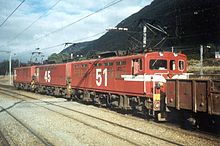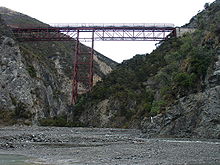- Midland Line, New Zealand
-
Midland Line
Two DX class locomotives hauling a 1,600 tonne coal train on the Midland lineOverview Type Heavy Rail System New Zealand railway network Status Open to passengers and freight Locale South Island, New Zealand Termini Rolleston
GreymouthOperation Opened 4 August 1923 (complete line) Owner ONTRACK Operator(s) KiwiRail
Tranz ScenicCharacter Secondary line Technical Line length 212 km (132 mi) Track gauge 1,067 mm (3 ft 6 in) Cape gauge Electrification 1500V DC (Arthurs Pass to Otira, 1923-1997) Maximum incline 3% (1 in 33) in Otira Tunnel Route map Legend


Main South Line to Lyttelton 


Main North Line to Picton 


0.5km / 0:00hr Christchurch 


0.0km / 0:01hr Start of Main North Line 


12.0km / 0:01hr Addington Junction 
Main South Line 
31.9km / 0:19hr Rolleston 


Main South Line to Timaru 
0.0km / 0:20hr Start of Midland Line 
0:38hr Darfield 


Whitecliffs Branch 


Oxford Branch (to Main North Line) 
Sheffield 
1:00hr Springfield 
Tunnel 1 
Tunnels 2 - 4 
Staircase viaduct 
Tunnels 5 - 7 
Tunnels 8 - 10 
Tunnels 11 - 16 
Waimakariri River bridge 
1:57hr Cass 
2:27hr Arthur's Pass 

Otira Tunnel 8,566 m (28,104 ft) 

2:48hr Otira 
3:07hr Jackson 
3:32hr Moana 
3:48hr Kokiri 


Stillwater - Westport Line 
4:07hr Brunner 


Rapahoe Branch (Formerly Rewanui Branch) 
212.0km / 4:30hr Greymouth 
Hokitika Branch (formerly to Ross) The Midland line is a 212 km section of railway between Rolleston and Greymouth in the South Island of New Zealand. The line features five major bridges, five viaducts and 17 tunnels, the longest of which is the Otira tunnel.
Contents
Passenger services
The famous Tranz Scenic train, the TranzAlpine, travels this line.
Freight services
Freight on the line depends largely on coal traffic, with other general freight being restricted to products from the Westland Milk Products factory at Hokitika. In 2003, Tranz Rail carried a total of 2.1 million tonnes of coal over the line.
Usually, coal services are headed by two class DX locomotives, and consist of 30 coal hopper wagons, with a total capacity of 1,800 tonnes.
On 27 November 2007, it was announced that coking coal from the Pike River Coal mine would be transported to Lyttelton for export. Pike River Coal has reserved under contract with Toll Rail 1.3 million tonnes of capacity for their coal on the line, which since upgrading has a total capacity of 4 million tonnes[1]. However services from the Pike River facility at Rapahoe have been curtailed since the series of explosions that killed 29 miners in November 2010, and the likelihood of further coal being transported from this source is in serious doubt.
The other primary source of coal traffic is from the Solid Energy facility at Ngakawau, north of Westport. Trains to and from Ngakawau use the Midland line as far as the junction with the Stillwater - Westport Line.
History
See also: New Zealand Midland Railway CompanyRailway development in the South Island in the 1870s was concentrated on a main line linking the established centres of Christchurch, Timaru, Dunedin and Invercargill and light, easily constructed branch lines serving the arable plains. These later included a branch to Springfield which was reached by January 1880.
In 1882 the East and West Coast Railway League was formed and in 1884 a Royal Commission, although fully aware of the construction difficulties of the Waimakariri Valley-Arthurs Pass route, as compared with the somewhat easier but longer Hurunui Valley-Harpers Pass route, chose the more direct route.
The construction of the line was rejected in 1883 by a Royal Commission, who argued that despite the significant timber and coal resources of the West Coast of the South Island, the line would not be economic, in the face of limited resources during the Premiership of Sir Julius Vogel, although Parliament did pass the East and West Coast and Nelson Railway Act to enable private interests to construct a line. The major obstacle to engineers and politicians was the Southern Alps. In 1886 the New Zealand Midland Railway Company was formed by Nelson and Canterbury business interests to construct the line, and the line from Westport to Nelson, and capital was raised in London by the firm to meet this end. The Company entered into a contract with the Government the same year.
For various reasons, the company managed to complete only 120 km of the line, and the Government exercised its right to take possession of the line in 1895, although protracted legal battles meant that full control was not achieved until 1900, with the line complete as far as Otira on the western side and Broken River on the eastern (Canterbury) side.
The major obstacle to the route lay immediately ahead: the forcing of the Waimakariri and Broken River gorges, some 8.5 miles (13 km) of the route surveyed by C. Napier Bell in 1883 and described to the Royal Commission by District Engineer W.N. Blair as "very rough, the mountain slope rises from the riverbed while the river runs in a fearful gorge all the way".
The section would include 16 tunnels and four major viaducts not including the Kowai already constructed. The viaducts were built under Treasury contracts by both New Zealand and British bridging firms. The most spectacular of these, the Staircase Viaduct carries the rails 240 feet above the bed of the stream.It was slow laborious work with men, horses, picks, shovels and very little machinery. It was not until 1906 that trains were running to a temporary terminus at Broken River – in time for the Christchurch Exhibition and at last enabling the journey, by rail and coach, from Greymouth to Christchurch to be completed in one day. Progress slowed after that although the country to be traversed became much easier. Cass was not reached until 1910 and Arthur's Pass township in 1914 – the Westland section meantime having advanced to Otira – to meet the other major obstacle.
Construction of Otira Tunnel began in 1907, but progress was very slow, and in the interim the eastern railhead reached Arthur's Pass in 1914. Cobb & Co coaches were used to transport passengers between the two railheads while the tunnel was under construction. The tunnel was finally completed in 1923.
Motive power
The line was unique in New Zealand for its captive use of many different types of locomotives. These locomotives include the KB class locomotives between Arthur's Pass and Springfield, once the most powerful steam locomotives in New Zealand. The class were made famous by a documentary named "KB country", a term that has entered into New Zealand railfan jargon. The Garratt G class, by then rebuilt as 'Pacific' type locomotives were also used on this route.
The Otira tunnel was electrified 1923-1997,and two classes of electric locomotives were used - the English Electric EO class and the NZR EA class. Some members of the EW class and ED class electric locomotives were also used.
Diesel traction was introduced to the line in 1968 with the arrival of the DJ class, which until the transfer of DC class locomotives in the early 1980s from the North Island was the dominant motive power on the line. Increasing volumes of coal traffic led to the introduction of the DX class, a number specially modified for use in the Otira Tunnel.
References
- ^ "Pike River Coal Announces New Coal Transport Route". Scoop.co.nz. 28 November 2007. http://www.scoop.co.nz/stories/BU0711/S00568.htm. Retrieved 2007-11-29.
External links
- Patterson's Creek viaduct (photo)
- Derailment near Cora Lynn, 1923 (photos)
- Derailment near Cora Lynn, 1923 (more photos)
- Ontrack: 90m Tunnel near Kiwi Point, Greymouth daylighted, 2011
Categories:- Railway lines in New Zealand
- 3ft 6in gauge railways
Wikimedia Foundation. 2010.




